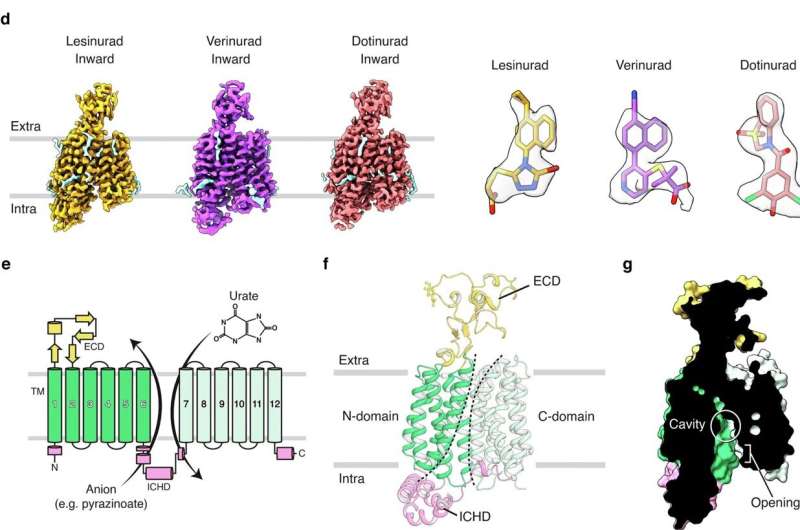This article has been reviewed according to Science X's editorial process and policies. Editors have highlighted the following attributes while ensuring the content's credibility:
fact-checked
peer-reviewed publication
trusted source
proofread
Urate transporter structures reveal the mechanism behind important drug target for gout

Scientists at St. Jude Children's Research Hospital have used cryo-electron microscopy to generate ten structures of URAT1, a protein linked to gout. Gout is a type of arthritis caused by excess urate levels, a byproduct of purine metabolism. URAT1 is a transporter that regulates urate levels, controlling its reabsorption in the kidneys.
Despite being a target for drugs used to treat gout, little was known about how URAT1 works or how mutations or drugs affect its activity. The new structures of URAT1, in combination with substrates and inhibitors, illuminate the mechanism by which URAT1 transports urate and offer insights for future drug discovery efforts. The findings are published in Cell Research.
The balance of metabolite production and removal is a finely regulated process orchestrated mainly by the kidneys. Tipping the balance either way, towards increased or decreased metabolite removal, has implications that can be felt throughout the body. Urate (uric acid) is a byproduct of the metabolism of purines, which produces compounds vital to DNA and RNA synthesis. When urate builds up, it can form crystals that accumulate in the joints and cause gout. URAT1 acts like a doorman to a busy club, promoting the re-entry of urate by moving chloride ions out of kidney cells.
A more holistic view on urate transport
Despite its vital link to diseases such as gout and its fundamental role in metabolic homeostasis, little was known about how URAT1 works. Some therapies exist for gout, but similarly, little was known about how they work. Chia-Hsueh Lee, Ph.D., Department of Structural Biology, sought to fill this gap in knowledge.
"We were interested to see if we could study the structural mechanism of this transporter, with the ultimate goal of developing better drugs to treat gout," Lee said.
URAT1 is a member of the SLC22 family of transporters, and while some structures are available for other family members, they all show the protein open towards the inside of the cell (inward-facing state).
"If you want to know the mechanism of a particular transporter, the more conformations you have, the better," said first author Yaxin Dai, Ph.D., Department of Structural Biology. "In our case, we captured three different confirmations: inward-facing, outward-facing and also a third, known as the occluded state, which means access to both the inside and outside of the cell is blocked."
They found that URAT1 functions quite differently compared to other SLC22 family members.
"The amino acid sequence of URAT1 shows that it has evolved to use different substrates, but without the structure, it was hard to tell which amino acids are really important," said Lee. "With these structures, we now know exactly which specific amino acids interact with the substrate, among those that differ from other SLC22 transporters."
Structures rationalize drug and disease mechanisms
The researchers followed up this mechanistic study by obtaining the structures of URAT1 in the presence of three gout therapeutics: lesinurad, verinurad and dotinurad.
"We can see the inhibitors very clearly, and in all three structures, URAT1 is in the inward-facing state. This clarity indicates that the inhibitors are very effective at keeping the protein in this conformation," Dai said. "From these observations, we conclude that the drugs work by locking URAT1 in the inward-facing state."
Along with offering insight into the transport mechanism of the protein and showing how gout drugs work, the structures also allowed the researchers to begin exploring the rationale behind URAT1 mutations linked to hypouricemia and other kidney diseases.
"Without structural information, it's challenging to understand how specific mutations affect the function of the transporter. Now we can map those genetic variations onto the structure and explain their effects," Lee said. "This is a big step forward to understanding diseases linked to URAT1."
More information: Yaxin Dai et al, Transport mechanism and structural pharmacology of human urate transporter URAT1, Cell Research (2024). DOI: 10.1038/s41422-024-01023-1



















